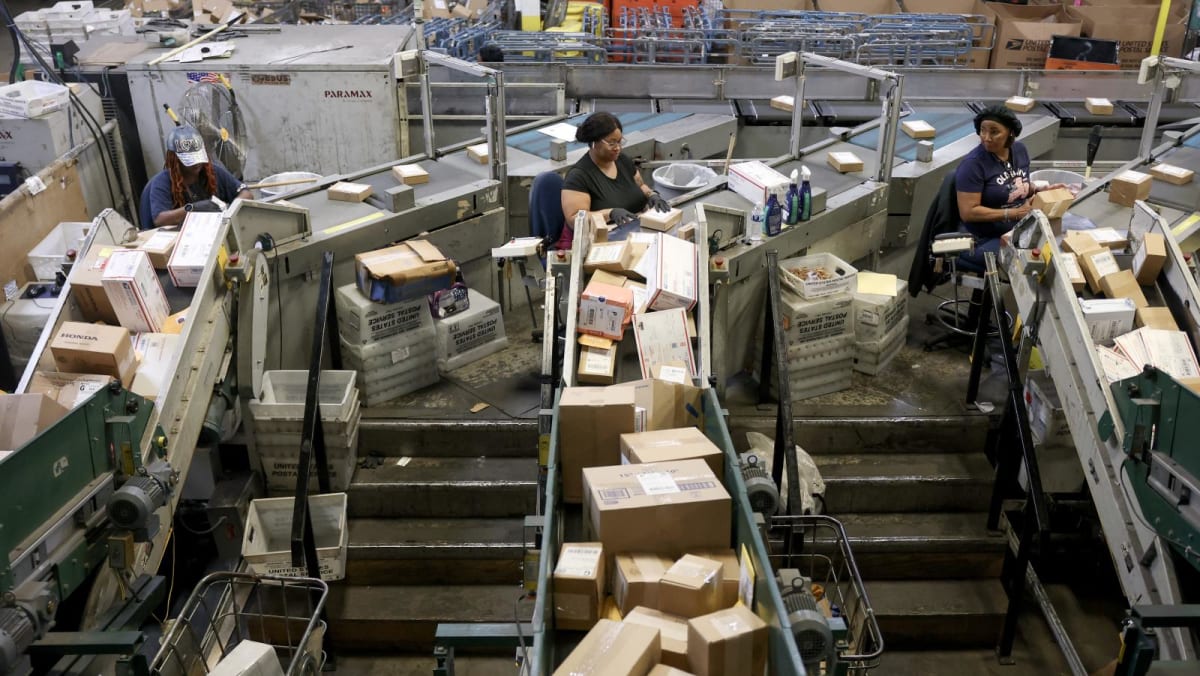SINGAPORE: Online shopping is tricky for someone as eco-conscious as Jian Ai, who works in Shanghai.
Like millions of her peers across the country doing their year-end holiday shopping online, the 30-year-old turns to popular sites like Taobao for the best gifts, clothes and accessories.
She goes the extra mile by looking to buy from environmentally responsible sellers offering biodegradable packaging but the sustainable option isn’t always the easiest, she says, especially when there are “very few eco-friendly” sellers on most Chinese e-commerce platforms.
And even with good intentions, many do not respond when she reaches out with suggestions to reduce plastic packaging.
 Jian Ai is part of China's new generation of younger and more eco-conscious shoppers. She often shares minimalist and green living tips on social media. (Image: Xiaohongshu/Jian Ai)
Jian Ai is part of China's new generation of younger and more eco-conscious shoppers. She often shares minimalist and green living tips on social media. (Image: Xiaohongshu/Jian Ai)
"I want to use less plastic so if I have the choice, I opt for the simplest packaging to reduce waste," the user interface (UI) app and website designer told CNA. "But a lot of shops tend to overpack or use a lot of cushioning materials."
She has chosen to buy from a Chinese aromatherapy skincare cosmetics brand called Arome Manpo because it uses paper cartons - which break down more easily as compared to plastic - to pack its goods.
“Many times we have no other options,” she said. “(And) you don’t really know until you receive the parcel.”
Young consumers like her are increasingly embracing sustainable lifestyles in China as the impacts of climate change continue to worsen.
Surveys have shown that Gen Zs, those born between 1995 and 2009, were more willing to pay a premium for greener options.
But whether this green wave is enough to turn the tide on plastic waste is another question, experts said.
 Shops on Chinese e-commerce platforms such as Taobao and JD.com offer more environmentally friendly parcel packaging options, but shoppers find that the choices are limited. (Images: Xiaohongshu/@Jian Ai, Bamidadao)
Shops on Chinese e-commerce platforms such as Taobao and JD.com offer more environmentally friendly parcel packaging options, but shoppers find that the choices are limited. (Images: Xiaohongshu/@Jian Ai, Bamidadao)
EXCESSIVE PACKAGING WASTE
Online shopping is notorious for using staggering amounts of non-biodegradable materials like plastics and styrofoam and the rapid rise of China’s thriving trillion dollar e-commerce industry, the largest in the world, is fuelling nearly five times more packaging waste as compared to in-person shopping.
Chinese brands, companies, shopping platforms and courier services have been steadily shifting their business practices to address environmental concerns and also meet growing expectations of younger consumers.
In a recent video posted on his Xiaohongshu account, Chen Shaogang, a 35-year-old web development engineer living in the eastern Zhejiang province, shared an interesting experience his friend had when receiving a parcel.
It came in a box that looked old and tattered from being reused many times, Chen said. “The delivery man asked us to remove the items from the box as he was taking it back,” he added.
 A special recyclable delivery box by SF Express, made of plastic polypropylene. (Image: Xiaohongshu/@Bamidadao)
A special recyclable delivery box by SF Express, made of plastic polypropylene. (Image: Xiaohongshu/@Bamidadao)
It was part of a special sustainable delivery service by SF Express, China’s largest express courier company. The recyclable box was made of polypropylene, a material widely recycled into many different types of products including fibers for clothes, industrial materials and kitchenware.
But shoppers like Chen say more can be done.
For starters, they are not always given greener packaging options, he told CNA. “The decision is made by logistics companies.”
Groups like Greenpeace have noted excessive amounts of paper, plastic and styrofoam widely used by Chinese e-commerce as well as courier companies during year-end blockbuster sales like Singles’ Day and in the lead-up to Christmas and Chinese New Year.
A comment shared on the Sina Weibo microblogging site by a user named Lunar Fang, said she received “big cardboard boxes filled with plastic bubble wrap and paper stuffing” for non fragile orders like pens and other stationary as well as clothes.
Another online shopper, Yue Wenjuan, from Liaoning province in northeastern China, shared that she finds online shopping to be challenging because of the amount of excessive packaging waste.
Yue, 37, is a content creator on social media platform Xiaohongshu. She advocates for sustainable living and often shares tips for eco-friendly living habits in her videos.
She told CNA that while she does her part by “buying only when necessary”, she often discards most of the packaging immediately after receiving her parcels and hopes Chinese brands and sellers will do more to minimise their carbon footprints, like offering higher-quality products to reduce the likelihood of returns, which generates more waste.
"If the quality is poor and people return the goods, this will, in turn, generate a larger carbon footprint due to delivery logistics," she added.
During the annual Singles’ Day shopping event this year, for instance, fashion e-retailers complained about high parcel return rates of up to 90 per cent.
In a 2023 report that examined the environmental commitment of various Chinese e-commerce companies, Greenpeace East Asia said the issue of “unnecessary over-packing” had become a “frequent frustration” for many online shoppers in China.
“Tempting but ultimately empty promises of cheap purchases follow shoppers wherever they go,” said Qilin Liu, the group’s international communications officer in Beijing.
“These platform companies have to move beyond the bottom line and think about their responsibilities to both the consumer and the environment.”
ECO-SHIFT OR “GIMMICK”?
China, the world’s biggest generator of plastic waste, has set ambitious goals to reduce carbon emissions and achieve carbon neutrality by 2060.
These have included a nationwide ban on the production and sale of non-biodegradable plastic bags and other products by 2025, as well as implementing greener initiatives like household and electronics trade-in programmes and supporting provincial governments in their transitions to “zero-waste”.
But even as Beijing scrambles to deliver on its ambitious climate goals, the volume of parcel deliveries and use of non-degradable materials in Chinese e-commerce and express delivery industries have continued to hit record highs.
Official figures released by China’s State Post Bureau (SPB), which regulates postal and delivery services, revealed that more than 12 billion packages were sent out nationwide for Singles’ Day this year, between Oct 21 and Nov 10, resulting in at least 2.4 million tonnes of packaging waste being generated.
“The pressure brought on by packaging waste on resources and the environment is closely related to people’s daily lives,” the SPB said in a statement that highlighted ongoing efforts to eliminate the use of secondary packaging and also utilise reusable and recyclable materials.
“As an emerging industry, the express delivery sector has developed rapidly in the past decade, while its relevant supporting laws, regulations and rules are still under exploration and improvement,” it added.
 Workers sort out parcels at a distribution center for e-commerce platform JD.com in Beijing, Monday, Nov. 11, 2024. (AP Photo/Andy Wong)
Workers sort out parcels at a distribution center for e-commerce platform JD.com in Beijing, Monday, Nov. 11, 2024. (AP Photo/Andy Wong)
Some of China’s leading online shopping portals and delivery service providers have taken action in recent years to reduce the use of plastics and paper, replacing non-biodegradable materials with recyclable packaging and reusable boxes.
Taobao, arguably China’s most popular shopping platform run by the Alibaba Group, has been promoting the use of biodegradable packaging through a “Green Parcel Initiative” while rival retail site JD.com has introduced similar environmental initiatives focusing on utilising sustainable packaging and recycling methods.
The use of “green packaging” materials like cardboard and other biodegradables, rose this year by 20 per cent during the Singles’ Day sales period, read a report by Alibaba's research arm, the Ali Research Institute.
The report also highlighted sustainability efforts by its Cainiao logistics courier service, which regularly reuses packing materials like cardboard boxes and utilises clean electricity to “reduce up to 298,000 tons of carbon emissions”.
Warehouse workers have also been “routinely sorting out” and recycling a total of 47.6 million cardboard boxes, the report said.
But such measures are “far from sufficient” and just “baby stepping”, said Wang Songlin, founder and chairman of the Qingdao Marine Conservation Society (QMCS), adding that express and food delivery services were still heavily reliant on plastic packaging - most of it single-use.
Guo Liangping, a Senior Research Fellow at the East Asian Institute at the National University of Singapore, dismissed green initiatives and pledges by Chinese e-commerce and courier companies as “gimmicks”.
“Companies are engaging in these gimmicks because it’s fashionable and helps improve their (public) image. However, it means little,” he told CNA.
The reality for many sellers and smaller companies on the ground also remains challenging.
The owner of a Brazilian jiu jitsu attire shop on Taobao, who did not wish to be identified, shared her dilemmas of using biodegradable delivery bags, which were “too thin and fragile” to transport purchases, especially heavy sports kits and equipment.
"Eco-friendly clothing bags are too thin and break easily. Considering the rough transportation process from factory to warehouse, these bags often fall apart before they reach the customer," she told CNA.
“I do what I can, using more eco-friendly materials, minimising packaging and skipping unnecessary freebies (but) I can’t completely avoid plastic right now,” she added.
 The owner of a Brazilian jiu-jitsu attire shop on Taobao shared her dilemma on social media about using biodegradable packaging for her products. (Image: Xiaohongshu/dadachuanzhang)
The owner of a Brazilian jiu-jitsu attire shop on Taobao shared her dilemma on social media about using biodegradable packaging for her products. (Image: Xiaohongshu/dadachuanzhang)
Not all customers were also on board with eco-friendlier options and efforts, she said, like minimising the amount of freebies to save on delivery services.
“If I don’t include small gifts, customers may think I’m being cheap or not thoughtful enough,” she said.
They also assume “quality is poor” is biodegradable packing is used, she added.
"If buyers understood the compromises we make for the environment, I’d switch entirely to eco-friendly materials. But the truth is many don’t care and judge quality by how premium the packaging looks. So, for now, I’ve limited my efforts to using biodegradable courier bags.”
Lu Xin, a 32-year-old business development manager from Hangzhou, confesses that she would prioritise cheaper costs over environmental sustainability.
This year, she spent around 1,500 yuan (US$210) buying clothes, gifts, home essentials and hair care and beauty products during the Singles’ Day sales period – all of which she said, had been securely delivered using standard materials like paper, cardboard and plastic resin packaging.
“I definitely hope that sellers ensure my products are not broken before considering environmental-friendly (packaging options),” Lu told CNA.
 Lu Xin ordered 1,500 yuan worth of items from Taobao this Singles’ Day, but none of them came in green packaging. (Photo: Lu Xin)
Lu Xin ordered 1,500 yuan worth of items from Taobao this Singles’ Day, but none of them came in green packaging. (Photo: Lu Xin)
CHANGING CONSUMER HABITS AND YOUTH TRENDS
Sustainable living remains a hot topic on Chinese social media platforms, where users and influencers actively promote eco-friendly products and share tips on going green in their everyday lives, like thrift shopping, taking public transport and cutting down on plastic food packaging and single-use disposables by reusing cup holders and tupperware boxes.
Surveys conducted by media agencies and outlets like China Trading Desk and Vogue Business in China, revealed pro-environmental attitudes of Gen Z respondents, who were more drawn to sustainable and recyclable products and packaging and willing to pay a premium for greener options.
Chinese Gen Z shoppers, as well as millennials, have been also known to adjust their online shopping habits “at least once in six months” over environmental concerns, the Vogue China report said.
A “Green Guilt Report” released in 2022 by market research and strategy consulting firm Daxue Consulting found an overwhelming 91 per cent of 1,000 respondents prioritising environmental sustainability when purchasing beauty products.
With younger Chinese consumers increasingly embracing sustainable lifestyles, industry players are optimistic about reducing excessive packaging waste in China’s e-commerce and delivery industries.
Younger shoppers, they say, could be a solution to drive meaningful environmental change in the country.
Speaking to Chinese state media outlets, Mu Min, Secretary-General of the China Association of Fragrance, Flavour and Cosmetic Industries, said consumer habits were shifting and younger shoppers were “increasingly willing to pay for sustainability”.
If greener packaging did not compromise on product quality and safety and was “not too expensive”, Chen said he would be open to the idea of paying slightly more for environmentally friendly options in future.
“It’s a good initiative but you see it without really feeling it,” he said.
While she might not see herself as a hardcore advocate, Jian Ai expressed willingness to pay more for eco-friendly packaging “if product quality was acceptable”.
“I’m really willing to pay the price difference,” she said, adding that she would spend up to 5 to 10 per cent more to ensure her buys contributed less to her carbon footprint.
To her, it’s simply about “doing a bit in her daily life for the environment”.










.jpg?itok=8vQxiINi)



































